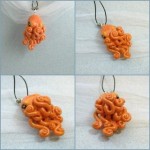One thing you should know about me is that I am from New York and I am half Italian. That means when I like something, I get highly animated about it. In person, I’ll start waving my arms around wildly to gesticulate my inner excitement. In writing, I will often use all caps and multiple exclamation points. I make no apologies for any of this.
When I first read this paper about microplastics, it was both horrible and great.
Horrible: There’s lots of microplastic. It’s deep, in squat lobsters and in the squishy bits of giant larvaceans. And highest concentrations of microplastic are below the surface.

Great: These are some sweet subsurface observations of microplastic, which we have very little of. Subsurface microplastic suspended in the water column has been suspected for a long time. As far as I know, this is the first research that definitely shows that. They used an ROV with a cool robotic arm/vacuum cleaner to make the samples.

I got to the conclusions, mulled over the joy and pain of the methods and the results, after which it hit me. DUH!!!! THE REASON WHY WE SEE PLASTICS BENEATH THE SURFACE IS BECAUSE THIS IS MONTEREY CANYON AND THAT TOTALLY JIVES WITH EVERYTHING WE ALREADY KNOW ABOUT IT!!
(Can you see my arms flapping, cause they are)

Let me explain. The truth is that it’s not only biologists that love Monterey Canyon, physical and geological oceanographers do too.
PEOPLE, THE WELL-KNOWN PROCESSES THAT TRANSPORT COASTAL SEDIMENT INTO THE INTERIOR OCEAN ARE PROBABLY DOING THE SAME THING TO MICROPLASTICS!!!
(at this point I may have either a) whacked something off a table, b) myself in the face, or c) both)
Monterey Canyon is a smorgasboard of physical and geological processes. There is a steep submarine canyon that winds its way from the shallow continental slope down the continental slope to the deep sea floor. Submarine waves break on its slopes that can create swash that washed up like white water on a beach. Oceanic avalanches laden with sediment instead of snow called turbidity currents scream down its spine. Strong coastal currents meander onto the precipice of the continental shelf. All these processes scour the slope, lifting the sediment that lies there into thin sheets that spread out far from the coast, suspended above the seafloor.
And that microplastic maximum, it’s at the same depth where you would expect to find one of these sediment layers.

Because this is a non-traditional blog, let’s have a non-traditional discussion section. I will barf some ideas at you like you are a tiny science baby bird, after which you will slowly digest them and then gain the knowledges.
DISCUSSION.
Microplastics could be flowing into the deep ocean along the same pathways that sediment is.
If we are finding microplastics where we are finding suspended sediment, that means the same processes are probably driving their transport. And they are complex.
What sinks at the coast doesn’t stay at the coast.
Sediment doesn’t, so microplastics won’t either. Even if dense microplastics sink when they first enter the ocean, they will eventually get swept up and moved away from shore.
Boundary layer mixing is important for sediment and now perhaps microplastic transport away from coasts.
Slopes, shelf breaks, canyons, ridges, bumps and even corrugations: these are all places where you find boundary layer mixing. This is probably where dense microplastics are getting mixed into the ocean.
END DISCUSSION.
Of course, this discussion session is speculative as most discussion sections are, and could be proven or disproven at any time. But, it’s fun and jives with what we already know about coastal processes. In any case, this is some provocative research that shows that plastics are getting into the deep ocean through a variety of pathways: physical and biological. And we need to keep working together to stop that.
Share the post "Don’t be shallow. A tale of subsurface microplastics and the processes that transport them."






Interesting!
By the way, the initial rocket stages of the satellites launched to polar orbits from Vandenberg Air Force Base must end somewhere “nearby” (well, maybe more south). As there have been over seven hundred launches from there (see Wikipedia, entry Spaceports), there must be an area at the bottom of the ocean with lots of large tin cans. I wonder if there are there similar “rusticle-microbes” that could eat also aluminium and/or titanium as those that eat cast iron or steel?